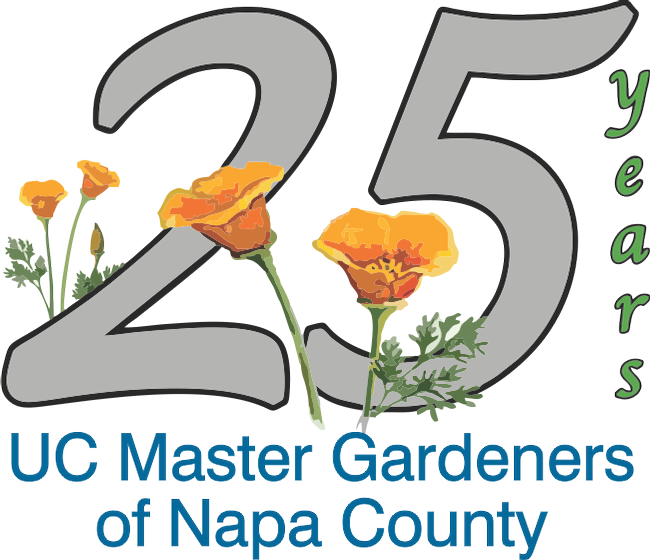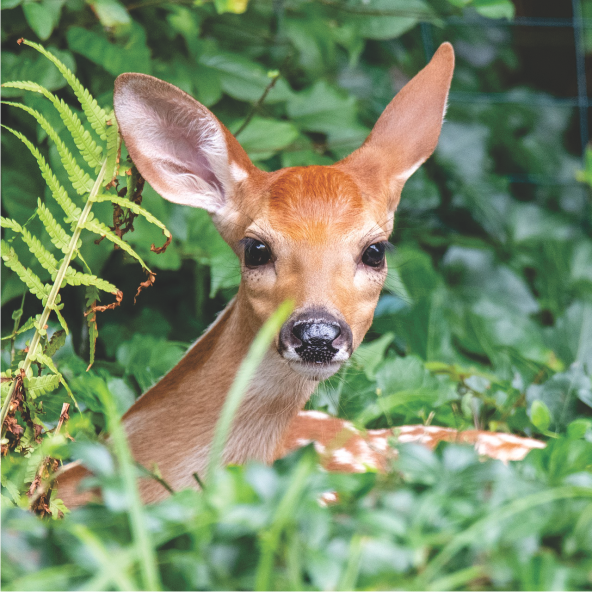To celebrate our 25th anniversary, UC Master Gardeners of Napa County asked the sole remaining member of the first class to share some garden tips.
by John Chwistek
- When a subdivision is built, the builder brings in soil and existing top soil is moved around to grade the lots. You can have different types of soil in your yard.

- After a heavy rain or irrigation, some parts of your garden might take longer to drain than others. It could be different soil types, compaction or how water moves out of your yard.
- Microclimates are important since house lots are getting smaller, houses are 2-3 stories and closer to the property line. Trees (yours or the neighbor), tall shrubs, tall fences can affect how much sunlight you have during the growing season. Observe your garden during different times of year to see when you have sun or shade over your garden beds and about how many hours. This will vary greatly during different seasons.
- When landscaping a new yard, draw a good design. Decide where to put the patio, service areas, lawn, vegetable garden, where to plant screen plants etc. This plan may evolve over time and you may have to replace plants as it changes.
- Be aware of how tall and wide plants will get, so you do not shade solar panels with trees or large shrubs or block pathways and needed access around the yard.
- Do not block your site lines near driveways and sidewalks. You need to see cars, people, etc., when backing out. And don't plant sharp, thorny or sticker-y plants near walkways or sidewalks; they may become a hazard.
- Plant plants in odd numbers, groups of 3, 5, 7 etc. This will make the planting look bigger. If plants are planted in even numbers you will divide the area in half and the planting will look smaller.
- If you are changing part of a landscape, use plants with similar leaf size so they will blend with the existing plants.
- Group plants with similar needs for light, water, soil type (clay, loam, sand etc.), and pH (acid loving plants).
- Give your plants the space they need to grow to mature height and spread. Don't let your plants grow into the neighbor's yard or plant too close to structures like fences where they will become a problem.
- No plants are truly deer resistant, but plants listed as resistant will work if there is enough natural food for the deer to eat. Unless they are roses, deer LOVE roses.
- If you live along a deer trail they will nibble on every plant and could damage them, but if there are enough plants they will not eat much of any one plant. Most plants will regrow. They generally do not like fuzzy or highly scented plants.
- Tall fences a deer cannot jump over is the best way to protect for your plants.

- To improve your soil and reduce pest problems rotate the families of vegetables and annual flowers planted in your garden beds.
- Don't plant warm season vegetables too early in spring. They need warm soil and longer days to grow well. Plant at the end of April through the 2nd week of June for best results.
- Mulch warm season vegetables one month after planting so the soil has time to warm-up.
- Cool season vegetables establish best while soil is still warm, so plant in late August through October. If planted into cool soil the seedling plants will not start to grow until the soil heats up again in spring.
- Plants that are grown for fruit, vegetables, nuts and flowers need to be fertilized and watered regularly to keep producing well.
- Bamboos and vines can be very useful as permanent to temporary screens. Plant in containers to help control running bamboo, vines, mints or other plants that have aggressive roots or that may be invasive.
- Plants grown in containers need to be repotted or transplanted regularly. A plant cannot stay in the same pot forever, unless you regularly repot and trim the roots – we call this a bonsai.
- Trees, shrubs and perennials bloom during certain times, not all season or year-round in our climate. However, with a little bit of planning and some careful choices you can create a garden that will have flowers year-round that will feed our local birds and pollinators, creating a habitat garden.
- Trees, shrubs and perennials do not live forever. With proper care and management, they will live to their maximum capacity but will have to be replaced eventually.
- Healthy plants can survive an insect or disease attack better than a stressed plant (planted in the wrong place, unusual weather, etc.)
- All plants require some maintenance during the year.
- If you would like more information about plants, insects, diseases, look for information on the following websites:
UC Master Gardeners of Napa County, napamg.ucanr.edu
See Garden Resources and Healthy Garden Tips
UC Davis IPM http://ipm.ucanr.edu/ ; UC Davis Arboretum https://arboretum.ucdavis.edu/ ;
UC Davis Backyard Orchard http://homeorchard.ucanr.edu/ ;
California Native Plant Society https://www.cnps.org/about/contact
Master Gardeners are following recommended social distancing guidelines that keep everyone safe, Napa Master Gardeners are available to answer garden questions by email: mastergardeners@countyofnapa.org. or phone at 707-253-4143. Volunteers will get back to you after they research answers to your questions.
Visit our website: napamg.ucanr.edu to find answers to all of your horticultural questions.
Photo credits: Pixabay, free photo

